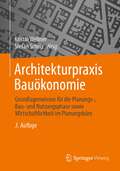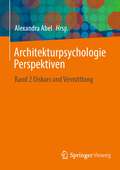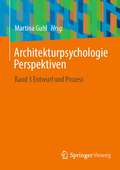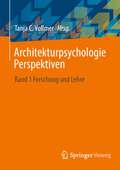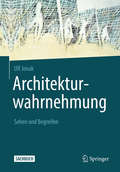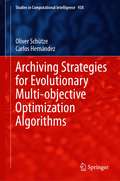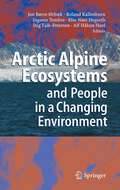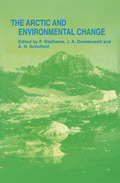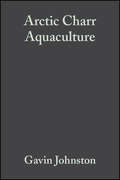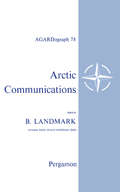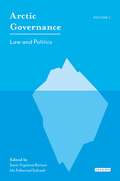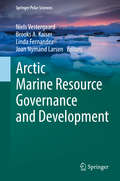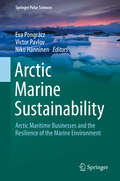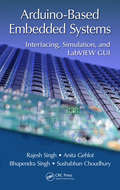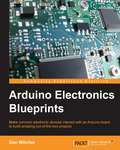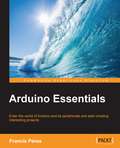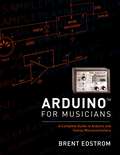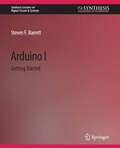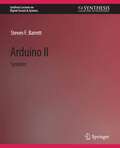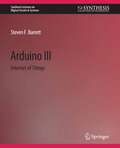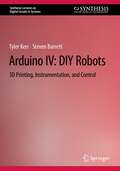- Table View
- List View
Architekturpraxis Bauökonomie: Grundlagenwissen für die Planungs-, Bau- und Nutzungsphase sowie Wirtschaftlichkeit im Planungsbüro
by Kristin Wellner Stefan ScholzDieses Lehrbuch stellt das komplexe Tätigkeitsfeld der Architekt*innen aus planerischer-, bauökonomischer und immobilienwirtschaftlicher Sicht dar. Die Aufgaben des*der Architekt*in werden prozessorientiert im Sinne des Planungs- und Bauprozesses dargestellt. Ein weiteres Thema ist die Wirtschaftlichkeit im Architekturbüro selbst. Das Lehrbuch gibt so – aufbauend auf den Einführungstexten in die Bauökonomie und Immobilienwirtschaft – einen Überblick über alle für die Architekt*innentätigkeit relevanten ökonomischen Inhalte und vertieft die besonders praxisrelevanten Themen ausführlich. Neu in der 3. Auflage: Das Thema Haftung wurde komplett überarbeitet und alle Rechtsthemen aktualisiert. Außerdem wurde Wert auf die übergreifende Einbindung der Bedeutung von Lebenszykluskostenanalyse und Digitalisierung gelegt.
Architekturpsychologie Perspektiven: Band 2 Diskurs und Vermittlung
by Alexandra AbelIn der gebauten und vom Menschen beeinflussten Umwelt manifestiert sich unser Leben: Lebenshaltung, Lebensformen, Lebensentwurf. Indem man Architektur neu denkt, hat man daher das Potential, die derzeitige Form unseres Lebens zu überdenken. Ein solches Neu, Anders braucht eine Sensibilisierung für die Relevanz der gebauten Umwelt, für die Werte und Zielgrößen, die hinter einer bestimmten Gestaltung stehen und braucht einen gesamtgesellschaftlichen Diskurs zu der zentralen Frage: Wie wollen wir leben? Wie dürfen wir leben? Vor dem Hintergrund ökologischer und ökonomischer Fairness: Welche Lebensformen sind kompatibel mit einer möglichst hohen Lebensqualität für uns alle, als Teil eines Ökosystems, mit dem unser Wohlbefinden unauflöslich verbunden ist. In diesem Band kommen namhafte Expertinnen aus Österreich, der Schweiz und Deutschland aus den Disziplinen der Architektur, der Psychologie, der Kunst und Kunstdidaktik zu Wort, die sich zu der Relevanz und zu den Voraussetzungen einer solchen Debatte äußern.
Architekturpsychologie Perspektiven: Band 3 Entwurf und Prozess
by Martina GuhlWie findet die Begegnung von Psychologie und Architektur während des Entwurfs- und Planungsprozesses statt? In welchem Planungsabschnitt wird architekturpsychologisches Wissen relevant und einsetzbar? Welche Erkenntnisse liefert die urbane Architekturpsychologie für den städtebaulichen Diskurs? In diesem Buch bringen renommierte Expert*innen aus Deutschland, der Niederlande und der Schweiz aus den Disziplinen Architektur, Psychologie, Städtebau, Farbgestaltung und Kommunikationspsychologie ihr Pionierwissen ein.
Architekturpsychologie Perspektiven: Band 1 Forschung und Lehre
by Tanja C. VollmerWas können wir aus der Forschung über die Wirkung von Architektur auf Gesundheit und Erleben der Menschen lernen? Wie vermitteln wir die interdisziplinären Erkenntnisse heute und morgen? In diesem Buch wird die Architekturpsychologie als Schlüsselkonzept der gesundheitsbezogenen Evidence Based Design Forschung vorgestellt. Dabei entwickeln renommierte Wissenschaftler:innen aus Deutschland, Dänemark und der Schweiz anhand verständlicher Beispiele ihre Forschungs- und Lehrperspektiven u.a. zum Krankenhaus-, Schul- und Städtebau sowie zum Design. Unterschiede der phänomenologischen, explorativen und empirischen Forschung werden herausgearbeitet sowie hilfreiche Modelle und Konzepte der modernen Architekturpsychologie erklärt. Einleitend wirft der Band einen Blick auf Entstehung und aktuellen Stand der Architekturpsychologie in Deutschland.
Architekturwahrnehmung: Sehen und Begreifen
by Ulf JonakWas ist Architekturwahrnehmung? Sicherlich ist sie Voraussetzung für praktisches Handeln. Aber was uns in diesem Zusammenhang mehr interessiert: Sie ist auch Voraussetzung von Architekturtheorie. Ist sie einfach die reflektierende Bewusstwerdung der gebauten Umwelt? Oder ist sie ein plötzlich sich offenbarendes Aha-Erlebnis, ein Gewahrwerden der Mauern um uns herum? Gründet sie auf einer Tradition des Nachdenkens über geplante oder ausgeführte Architektur? Hilft uns zum Verständnis das Kompendium der Texte, mit denen Architekten ihr eigenes Werk schriftlich interpretieren? Oder schadet etwa unserer Aufnahmefähigkeit („wegen Überfüllung geschlossen“) die Kenntnis all dessen, was zum Bauen gesagt wurde (von Vitruv bis Koolhaas), also der Fülle der schriftlichen Überlieferung?
Archiving Strategies for Evolutionary Multi-objective Optimization Algorithms (Studies in Computational Intelligence #938)
by Oliver Schütze Carlos HernándezThis book presents an overview of archiving strategies developed over the last years by the authors that deal with suitable approximations of the sets of optimal and nearly optimal solutions of multi-objective optimization problems by means of stochastic search algorithms. All presented archivers are analyzed with respect to the approximation qualities of the limit archives that they generate and the upper bounds of the archive sizes. The convergence analysis will be done using a very broad framework that involves all existing stochastic search algorithms and that will only use minimal assumptions on the process to generate new candidate solutions. All of the presented archivers can effortlessly be coupled with any set-based multi-objective search algorithm such as multi-objective evolutionary algorithms, and the resulting hybrid method takes over the convergence properties of the chosen archiver. This book hence targets at all algorithm designers and practitioners in the field of multi-objective optimization.
Arctic Alpine Ecosystems and People in a Changing Environment
by Ingunn Tombre Else N. Hegseth Stig Falk-Petersen Alf H. Hoel Jon Børre Ørbaek Roland KallenbornThe European Arctic and Alpine regions are experiencing large environmental changes. These changes may have socio-economic effects if the changes affect the bioproduction, which form the basis for the marine and terrestrial food chains. This uniquely multidisciplinary book presents the various aspects of contemporary environmental changes in Arctic and Alpine Regions.
Arctic and Environmental Change
by J. A. DowdeswellThis timely book presents a wide-ranging review of Arctic environmental change in response to global warming, and gives a broad insight into the transformation of the Arctic which we can expect during the next century. It is in high northern latitudes that we can expect to observe global warming at its most powerful, making it a natural laboratory where climate changes and their impacts can be monitored and studied more readily than elsewhere in the world. Fourteen authoritative reviews cover the predictions of warming rates by General Circulation Models; variabilities in atmospheric circulation and moisture flux; the dynamics of the polar vortex in the Arctic and its role in ozone loss; the countervailing influence of air pollution in reducing solar irradiance; and the impact of climatic change on Arctic terrestrial and marine ecosystems. Also detailed are the thermohaline circulation of the ocean, the extent and thickness of sea ice, the sizes of glaciers and ice sheets, and the extent of permafrost. Moving to past changes, the records from Greenland ice cores and deep ocean drilling are reviewed for what they tell us about past climates and glaciation in the Arctic., The book paints a vivid and disturbing picture of the enhanced warming that can be expected in the Arctic relative to lower latitudes, and of the major impacts that this will have on the northern cryosphere. It will be an invaluable reference for anyone seeking a greater understanding of the factors and processes affecting the arctic environment, which may ultimately have a major impact on global climatic change.
Arctic and Environmental Change
by J. A. DowdeswellThis timely book presents a wide-ranging review of Arctic environmental change in response to global warming, and gives a broad insight into the transformation of the Arctic which we can expect during the next century. It is in high northern latitudes that we can expect to observe global warming at its most powerful, making it a natural laboratory where climate changes and their impacts can be monitored and studied more readily than elsewhere in the world. Fourteen authoritative reviews cover the predictions of warming rates by General Circulation Models; variabilities in atmospheric circulation and moisture flux; the dynamics of the polar vortex in the Arctic and its role in ozone loss; the countervailing influence of air pollution in reducing solar irradiance; and the impact of climatic change on Arctic terrestrial and marine ecosystems. Also detailed are the thermohaline circulation of the ocean, the extent and thickness of sea ice, the sizes of glaciers and ice sheets, and the extent of permafrost. Moving to past changes, the records from Greenland ice cores and deep ocean drilling are reviewed for what they tell us about past climates and glaciation in the Arctic., The book paints a vivid and disturbing picture of the enhanced warming that can be expected in the Arctic relative to lower latitudes, and of the major impacts that this will have on the northern cryosphere. It will be an invaluable reference for anyone seeking a greater understanding of the factors and processes affecting the arctic environment, which may ultimately have a major impact on global climatic change.
Arctic Charr Aquaculture
by Gavin JohnstonThis important book draws together, for the first time, a vast wealth of information on all major aspects of the farming of Arctic charr, a highly prized and commercially valuable salmonid. The author, Gavin Johnston who has many years' experience of farming Arctic charr, teaching about and researching the species, has produced a book that is a landmark publication and an essential purchase for all those involved with the species. The book is broadly divided into three sections. The first section covers Arctic charr interactions with humans and the charr's biological requirements for culture. Section two is a practical guide to the art and science of early-rearing Arctic charr; a hands on application of current knowledge in Arctic charr aquaculture. The final section of the book focuses on the commercial production of Arctic charr, providing cutting-edge information for all those involved in the exploitation of this valuable species. Arctic Charr Aquaculture is an essential purchase for anyone involved in, or considering involvement in farming of this species. Farm managers and other personnel in fish farms and experimental aquaculture units, fish and aquatic biologists will find a huge amount of useful data in this book. Libraries in all university departments and research establishments where aquaculture, fisheries and fish biology are studies and taught should have copies of this book on their shelves. This book brings together for the first time the knowledge needed to farm and market Arctic Charr. Part One is an overview of Arctic Charr aquaculture beginning with the history and development of Charr aquaculture, the biological attributes of Arctic Charr, the physical requirements for growth and commercial production requirements. Other chapters are devoted to Charr health, nutrition and feeding. Part Two is a practical guide for the producer operating an Arctic Charr farm either as a vertically integrated operation or as discrete hatcheries and grow out farms. Part Three is devoted to the business of commercially producing Arctic Charr, and although it deals specifically with Charr it also covers many business aspects of farming relevant to any fish species under cold water cultivation. It covers farm business management, the economics and finance of Arctic Charr farming, marketing Charr products and a closing section on how to avoid the pitfalls which others including the author have experienced.
Arctic Communications: Proceedings of the Eighth Meeting of the AGARD Ionospheric Research Committee, Athens, Greece, July 1963
by B. LandmarkArctic Communications is a compilation of the proceedings of the Eighth Meeting of the Ionospheric Research Committee of NATO's Advisory Group for Aeronautical Research and Development, held in Athens, Greece in July 1963. The meeting provided a forum for discussing advances in communications equipment used to conduct research in the Arctic and covered a wide range of topics such as the physical properties of the Arctic ionosphere; Arctic high-frequency communications; soundings and field strength measurements; and observations in the Arctic during nuclear tests. This book is comprised of 25 chapters and begins with a discussion on experimental studies of high latitude absorption phenomena, including auroral absorption, polar cap absorption, and sudden commencement absorption. Direct measurements of D-region electron densities during the absorption periods are also presented. Subsequent chapters focus on the ionospheric absorption of cosmic noise observed at geomagnetically conjugate points; ionospheric ionization produced by solar flares; military communication facilities in the Canadian Arctic; and radio noise problems in Arctic regions. Phase instabilities on a very-low-frequency transmission path passing through the auroral zone are also considered. This monograph will be of particular value to scientists and researchers with interest in the Arctic.
Arctic Governance: Law and Politics (Arctic Governance Ser. #Vol. 1)
by Svein Vigeland Rottem Ida Folkestad SoltvedtThe Polar North is known to be home to large gas and oil reserves and its position holds significant trading and military advantages, yet the territorial boundaries of the region remain ill-defined. In the 21st century the Arctic continent is undergoing profound change. As the sea ice melts, a result of accelerating climate change, global governance has become vital. The Polar North is known to be home to large gas and oil reserves and its position holds significant trading and military advantages, yet the territorial boundaries of the region remain ill-defined. In the 21st century the Arctic continent is undergoing profound change. As the sea ice melts, a result of accelerating climate change, global governance has become vital. In this first of three volumes, the latest research and analysis from the world's leading Arctic research body - the Fridtjof Nansen Institute - is brought together for the first time. Arctic Governance: Law and Power investigates the political contexts and international tensions surrounding the actions of nation states, focusing especially on the disputes which have emerged where European, American and Russian interests compete directly. Skillfully delineating policy in the region, and analyzing the legal and political consequences of treaty agreements, Arctic Governance will become an indispensable handbook to contemporary International Relations concerning the Polar North.
Arctic Marine Resource Governance and Development (Springer Polar Sciences)
by Niels Vestergaard Brooks A. Kaiser Linda Fernandez Joan Nymand LarsenThis book is based on presentations from the Conference ‘Arctic Marine Resource Governance’ held in Reykjavik Iceland in October 2015. The book is divided into four main themes: 1. Global management and institutions for Arctic marine resources 2. Resource stewards and users: local and indigenous co-management 3. Governance gaps in Arctic marine resource management and 4. Multi-scale, ecosystem-based, Arctic marine resource management’. The ecosystem changes underway in the Arctic region are expected to have significant impacts on living resources in both the short and long run, and current actions and policies adopted over such resource governance will have serious and ultimately irreversible consequences in the near and long terms.
Arctic Marine Sustainability: Arctic Maritime Businesses and the Resilience of the Marine Environment (Springer Polar Sciences)
by Eva Pongrácz Victor Pavlov Niko HänninenThis book presents the latest scientific views on resource use conflicts in the Arctic seas. The main areas of focus are the biological resources of Arctic seas vs. exploitation of oil and gas resources, and the conflicts in between. In addition, climate change is presented as a stressor, which both limits and facilitates the economic availability of resources in the Arctic. The book is divided into five parts. Part 1 examines Arctic ecosystems, resilience of the marine environment and possible conflicts between industrial sector and biological world. The focus of Part 2 is on transport infrastructure along the northern routes. Issues such as Arctic maritime operations, black carbon and unmanned aerial vehicles are considered. Part 3 focuses on resource use conflicts in Arctic seas and on the most recent threats in terms of Arctic oil and gas exploration, offshore logistics operations as well as transportation of oil and oil products. Discussions in Part 4 of the book are concentrated around social aspects and involvement of local communities. Tourism development, preservation of indigenous culture, engagement of communities on relevant Arctic issues, search and rescue in the cold marine environment are examples of questions raised. The book reviews Arctic-specific petroleum regulations, the state of preparedness to oil spill accidents in the region as well as the latest developments in oil spill response technologies and their limitations. Search and rescue operations are reviewed and how working in this harsh Arctic environment affects the ability of rescue technicians to perform the required technical skills. Part 5 considers the sustainability challenges arising from the marine resource exploitation. The focus is on the vulnerability of Arctic ecosystems to disturbance – both natural and anthropogenic.
Arctic Underwater Operations: Medical and Operational Aspects of Diving Activities in Arctic Conditions
by LouisReyOpening Speech of the ICEDIVE 84 Conference by His Royal Highness Prince Bertil of Sweden I am very pleased to be invited to open the International Conference ICEDIVE 84, dealing with medical and technical problems of diving and related underwater activities in arctic conditions. Until recent times, the arctic was considered astrange and remote area of minor importance. However, in a world with diminishing natural resources, arctic areas have become a region of global importance because of their enormous resources and strategie position. Certain experts believe that more than 50% of oil reserves are "sleeping" in these northern areas which are cold, harsh and hostile to man. Operations in arctic areas are extremely difficult, expensive, and demand high levels of technical, scientific and physiological achievement. One should recall for example, that Alaskan oil investment onIy became economically viable after the 1973-1974 price explosion. Recent political/military troubles in the Gulf have increased interest in the development of polar resources. This conference is unique as it is the first time that medical and technical specialists interested in the problem of diving in arctic conditions have met in an international forum. Development of the arctic resources is a matter of international urgency, and it pleases me that scientists from the USA, Canada, the USSR, Australia and Europe have gathered here in Stockholm to present their experience and to discuss problems in this field.
Arduino-Based Embedded Systems: Interfacing, Simulation, and LabVIEW GUI
by Rajesh Singh Anita Gehlot Bhupendra Singh Sushabhan ChoudhuryArduino is an open-source electronics platform based on easy-to-use hardware and software while LabVIEW is a graphical programming telling how to connect functions and work with a variety of datatypes when constructing applications.This book will help beginners to get started with Arduino-based embedded systems including essential know-how of the programming and interfacing of the devices. Book includes programming and simulation of Arduino-based projects and interfacing with LabVIEW, based on practical case studies. The book comprises of total twenty five chapters with description, working model of LabVIEW and programming with Arduino IDE.
Arduino-Based Embedded Systems: Interfacing, Simulation, and LabVIEW GUI
by Rajesh Singh Anita Gehlot Bhupendra Singh Sushabhan ChoudhuryArduino is an open-source electronics platform based on easy-to-use hardware and software while LabVIEW is a graphical programming telling how to connect functions and work with a variety of datatypes when constructing applications.This book will help beginners to get started with Arduino-based embedded systems including essential know-how of the programming and interfacing of the devices. Book includes programming and simulation of Arduino-based projects and interfacing with LabVIEW, based on practical case studies. The book comprises of total twenty five chapters with description, working model of LabVIEW and programming with Arduino IDE.
Arduino Electronics Blueprints
by Don WilcherThis book is intended for those who want to learn about electronics and coding by building amazing devices and gadgets with Arduino. If you are an experienced developer who understands the basics of electronics, then you can quickly learn how to build smart devices using Arduino. The only experience needed is a desire to learn about electronics, circuit breadboarding, and coding.
Arduino Essentials
by Francis PereaIf you are a hobbyist who wants to develop projects based on Arduino as the main microcontroller platform or an engineer interested in finding out what the Arduino platform offers, then this book is ideal for you. Some prior knowledge of the C programming language is required.
Arduino for Musicians: A Complete Guide to Arduino and Teensy Microcontrollers
by Brent EdstromArduino, Teensy, and related microcontrollers provide a virtually limitless range of creative opportunities for musicians and hobbyists who are interested in exploring "do it yourself" technologies. Given the relative ease of use and low cost of the Arduino platform, electronic musicians can now envision new ways of synthesizing sounds and interacting with music-making software. In Arduino for Musicians, author and veteran music instructor Brent Edstrom opens the door to exciting and expressive instruments and control systems that respond to light, touch, pressure, breath, and other forms of real-time control. He provides a comprehensive guide to the underlying technologies enabling electronic musicians and technologists to tap into the vast creative potential of the platform. Arduino for Musicians presents relevant concepts, including basic circuitry and programming, in a building-block format that is accessible to musicians and other individuals who enjoy using music technology. In addition to comprehensive coverage of music-related concepts including direct digital synthesis, audio input and output, and the Music Instrument Digital Interface (MIDI), the book concludes with four projects that build on the concepts presented throughout the book. The projects, which will be of interest to many electronic musicians, include a MIDI breath controller with pitch and modulation joystick, "retro" step sequencer, custom digital/analog synthesizer, and an expressive MIDI hand drum. Throughout Arduino for Musicians, Edstrom emphasizes the convenience and accessibility of the equipment as well as the extensive variety of instruments it can inspire. While circuit design and programming are in themselves formidable topics, Edstrom introduces their core concepts in a practical and straightforward manner that any reader with a background or interest in electronic music can utilize. Musicians and hobbyists at many levels, from those interested in creating new electronic music devices, to those with experience in synthesis or processing software, will welcome Arduino for Musicians.
ARDUINO FOR MUSICIANS C: A Complete Guide to Arduino and Teensy Microcontrollers
by Brent EdstromArduino, Teensy, and related microcontrollers provide a virtually limitless range of creative opportunities for musicians and hobbyists who are interested in exploring "do it yourself" technologies. Given the relative ease of use and low cost of the Arduino platform, electronic musicians can now envision new ways of synthesizing sounds and interacting with music-making software. In Arduino for Musicians, author and veteran music instructor Brent Edstrom opens the door to exciting and expressive instruments and control systems that respond to light, touch, pressure, breath, and other forms of real-time control. He provides a comprehensive guide to the underlying technologies enabling electronic musicians and technologists to tap into the vast creative potential of the platform. Arduino for Musicians presents relevant concepts, including basic circuitry and programming, in a building-block format that is accessible to musicians and other individuals who enjoy using music technology. In addition to comprehensive coverage of music-related concepts including direct digital synthesis, audio input and output, and the Music Instrument Digital Interface (MIDI), the book concludes with four projects that build on the concepts presented throughout the book. The projects, which will be of interest to many electronic musicians, include a MIDI breath controller with pitch and modulation joystick, "retro" step sequencer, custom digital/analog synthesizer, and an expressive MIDI hand drum. Throughout Arduino for Musicians, Edstrom emphasizes the convenience and accessibility of the equipment as well as the extensive variety of instruments it can inspire. While circuit design and programming are in themselves formidable topics, Edstrom introduces their core concepts in a practical and straightforward manner that any reader with a background or interest in electronic music can utilize. Musicians and hobbyists at many levels, from those interested in creating new electronic music devices, to those with experience in synthesis or processing software, will welcome Arduino for Musicians.
Arduino I: Getting Started (Synthesis Lectures on Digital Circuits & Systems)
by Steven F. BarrettThis book is about the Arduino microcontroller and the Arduino concept. The visionary Arduino team of Massimo Banzi, David Cuartielles, Tom Igoe, Gianluca Martino, and David Mellis launched a new innovation in microcontroller hardware in 2005, the concept of open-source hardware. Their approach was to openly share details of microcontroller-based hardware design platforms to stimulate the sharing of ideas and promote innovation. This concept has been popular in the software world for many years. In June 2019, Joel Claypool and I met to plan the fourth edition of Arduino Microcontroller Processing for Everyone! Our goal has been to provide an accessible book on the rapidly changing world of Arduino for a wide variety of audiences including students of the fine arts, middle and senior high school students, engineering design students, and practicing scientists and engineers. To make the book more accessible to better serve our readers, we decided to change our approach and provide a series of smaller volumes. Each volume is written to a specific audience. This book, Arduino I: Getting Started is written for those looking for a quick tutorial on the Arduino environment, platforms, interface techniques, and applications. Arduino II will explore advanced techniques, applications, and systems design. Arduino III will explore Arduino applications in the Internet of Things (IoT). Arduino I: Getting Started covers three different Arduino products: the Arduino UNO R3 equipped with the Microchip ATmega328, the Arduino Mega 2560 equipped with the Microchip ATmega2560, and the wearable Arduino LilyPad.
Arduino II: Systems (Synthesis Lectures on Digital Circuits & Systems)
by Steven F. BarrettThis book is about the Arduino microcontroller and the Arduino concept. The visionary Arduino team of Massimo Banzi, David Cuartielles, Tom Igoe, Gianluca Martino, and David Mellis launched a new innovation in microcontroller hardware in 2005, the concept of open-source hardware. Their approach was to openly share details of microcontroller-based hardware design platforms to stimulate the sharing of ideas and promote innovation. This concept has been popular in the software world for many years. In June 2019, Joel Claypool and I met to plan the fourth edition of Arduino Microcontroller Processing for Everyone! Our goal has been to provide an accessible book on the rapidly evolving world of Arduino for a wide variety of audiences including students of the fine arts, middle and senior high school students, engineering design students, and practicing scientists and engineers. To make the book even more accessible to better serve our readers, we decided to change our approach and provide a series of smaller volumes. Each volume is written to a specific audience. This book, Arduino II: Systems, is a detailed treatment of the ATmega328 processor and an introduction to C programming and microcontroller-based systems design. Arduino I: Getting Started provides an introduction to the Arduino concept. Arduino III: the Internet of Things explores Arduino applications in the Internet of Things (IoT).
Arduino III: Internet of Things (Synthesis Lectures on Digital Circuits & Systems)
by Steven F. BarrettThis book is about the Arduino microcontroller and the Arduino concept. The visionary Arduino team of Massimo Banzi, David Cuartielles, Tom Igoe, Gianluca Martino, and David Mellis launched a new innovation in microcontroller hardware in 2005, the concept of open-source hardware. Their approach was to openly share details of microcontroller-based hardware design platforms to stimulate the sharing of ideas and promote innovation. This concept has been popular in the software world for many years. In June 2019, Joel Claypool and I met to plan the fourth edition of Arduino Microcontroller Processing for Everyone! Our goal has been to provide an accessible book on the rapidly evolving world of Arduino for a wide variety of audiences including students of the fine arts, middle and senior high school students, engineering design students, and practicing scientists and engineers. To make the book even more accessible to better serve our readers, we decided to change our approach and provide a series of smaller volumes. Each volume is written to a specific audience. This book, Arduino III: Internet of Things, explores Arduino applications in the fascinating and rapidly evolving world of the Internet of Things. Arduino I: Getting Started provides an introduction to the Arduino concept. Arduino II: Systems, is a detailed treatment of the ATmega328 processor and an introduction to C programming and microcontroller-based systems design.
Arduino IV: 3D Printing, Instrumentation, and Control (Synthesis Lectures on Digital Circuits & Systems)
by Tyler Kerr Steven BarrettThis book gives a step-by-step introduction to designing and building your own robots. As with other books in the Arduino series, the book begins with a quick overview of the Arduino Integrated Development Environment (IDE) used to write sketches, and the hardware systems aboard the Arduino UNO R3 and the Mega 2560 Rev 3. The level of the text makes it accessible for students, hobbyist and professionals' first introduction to both Arduino and Robotics. This book will be accessible by all levels of students, advanced hobbyists and engineering professionals, whether using as a self-reference or within a structure design laboratory. The text then examines the many concepts and characteristics common to all robots. In addition, throughout the book , reasonably priced, easily accessible and available off-the-shelf robots are examined. Examples include wheeled robots, tracked robots and also a robotic arm. After a thorough and easy to follow Arduino IDE and hardware introduction, the book launches into “do it yourself” or DIY concepts. A unique feature of the book is to start with a hands-on introduction to low cost 3D printing. These concepts will allow you to design and print your own custom robot parts and chassis. We then explore concepts to sense a robot's environment, move the robot about and provide a portable power source. We conclude with a several DIY robot projects.
